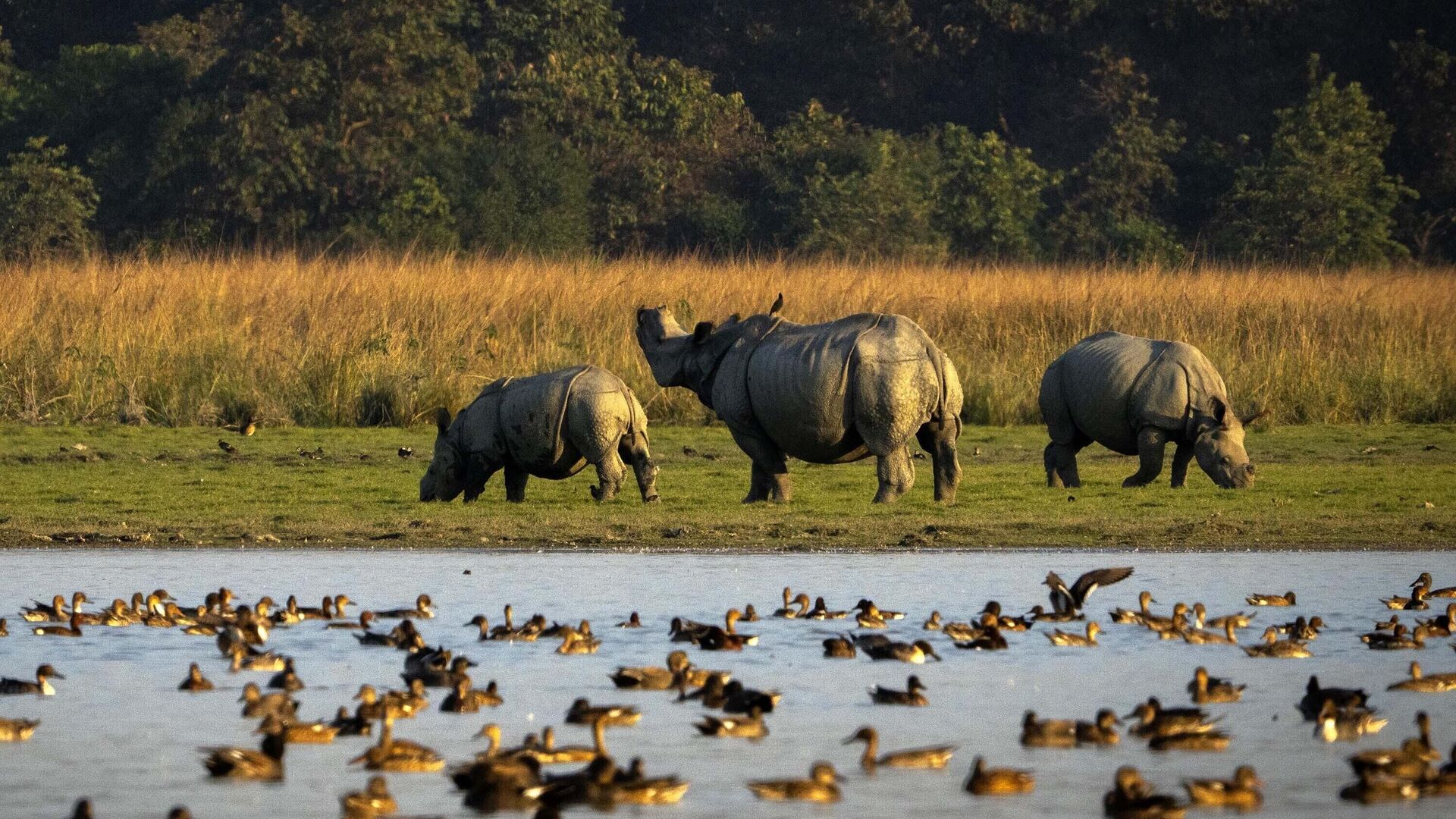https://sputnikglobe.com/20230120/african-rhino-population-declining-in-state-run-parks-growing-on-private-lands-study-reveals-1106531776.html
African Rhino Population Declining in State-Run Parks, Growing on Private Lands, Study Reveals
African Rhino Population Declining in State-Run Parks, Growing on Private Lands, Study Reveals
Sputnik International
A new study has revealed that at least half of Africa’s remaining rhinos are being conserved on private and communal lands, while the number of the animal are decreasing in state-run parks.
2023-01-20T16:22+0000
2023-01-20T16:22+0000
2023-01-20T16:22+0000
africa
rhino
rhinos
white rhino
conservation
https://cdn1.img.sputnikglobe.com/img/07e7/01/14/1106531915_0:156:3001:1844_1920x0_80_0_0_eda93bd21fe26c7775c2670f2b658ac9.jpg
A new study has revealed that at least half of Africa’s remaining rhinos are being conserved on private and communal lands, while the population of the animal is decreasing in state-run parks across the continent, which is home to the majority of the world’s remaining rhinos.The study was carried out jointly by scholars from the University of Helsinki in Finland and the Universities of Stellenbosch and Nelson Mandela in South Africa, which hosts nearly 70% percent of the African rhino population.Published in Frontiers in Ecology and the Environment scientific journal, the study showed that Kruger National Park in South Africa had lost 76% of its white rhino population, along with 68% of the black ones, over the past decade. In the meantime, the numbers of rhinos on private lands in the country steadily grew over the same period.Speaking of the factors behind the emerging shift in rhino conservation from state to private and communal lands, study co-author Dr. Dave Balfour explained that the cost-benefit ratio of conserving rhinos is changing, with private rhino owners spending on average $150,000 per year on security measures. Such high expenses per rhino or per unit area conserved are not affordable by state-owned parks, according to the researcher.The scientists suggested future policies enabling more incentives that would compensate for rising security expenses, as well as encouraging the conservation of rhinos on private and communal lands.He added that such questions should be addressed by regional governments and other concerned parties in order to “support more sustainable conservation strategies for rhinos.”The scholars cautioned that failure to enable additional incentives could risk “losing private and communal rhino custodians, and with them, half of the remaining African rhinos.”They added that governments should be more transparent in providing up-to-date information about rhino numbers and their management, which is critical for understanding where and how best to conserve them.The two African rhino species, white and black, are found in 15 countries across the continent, including South Africa (68%), Namibia (15%), Kenya (8%), and Zimbabwe (5%).
africa
Sputnik International
feedback@sputniknews.com
+74956456601
MIA „Rosiya Segodnya“
2023
Muhammad Nooh Osman
https://cdn1.img.sputnikglobe.com/img/07e4/08/0e/1080170965_2:0:2050:2048_100x100_80_0_0_1de8233c87df0979e7e74f61b6ffacad.jpg
Muhammad Nooh Osman
https://cdn1.img.sputnikglobe.com/img/07e4/08/0e/1080170965_2:0:2050:2048_100x100_80_0_0_1de8233c87df0979e7e74f61b6ffacad.jpg
News
en_EN
Sputnik International
feedback@sputniknews.com
+74956456601
MIA „Rosiya Segodnya“
Sputnik International
feedback@sputniknews.com
+74956456601
MIA „Rosiya Segodnya“
Muhammad Nooh Osman
https://cdn1.img.sputnikglobe.com/img/07e4/08/0e/1080170965_2:0:2050:2048_100x100_80_0_0_1de8233c87df0979e7e74f61b6ffacad.jpg
african rhino, rhino population, white rhino, black rhino, rhino conservation, rhino in africa, rhino in south africa, rhino on private lands,
african rhino, rhino population, white rhino, black rhino, rhino conservation, rhino in africa, rhino in south africa, rhino on private lands,
African Rhino Population Declining in State-Run Parks, Growing on Private Lands, Study Reveals
Muhammad Nooh Osman
Writer/Editor
As of 2022, the population of rhinos in Africa was estimated to be 22,137, including 6,195 black rhinos and 15,942 white rhinos, according to a report released by the African Rhino Specialist Group (AfRSG) of the International Union for Conservation of Nature (IUCN). Since the previous AfRSG report in 2017, the number decreased by 6%, from 23,562.
A new study has revealed that at least half of Africa’s remaining rhinos are being conserved on private and communal lands, while the population of the animal is decreasing in state-run parks across the continent, which is home to the majority of the world’s remaining rhinos.
The study was carried out jointly by scholars from the University of Helsinki in Finland and the Universities of Stellenbosch and Nelson Mandela in South Africa, which hosts nearly 70% percent of the African rhino population.
Published in Frontiers in Ecology and the Environment scientific journal, the study showed that Kruger National Park in South Africa had lost 76% of its white
rhino population, along with 68% of the black ones, over the past decade. In the meantime, the numbers of rhinos on private lands in the country steadily grew over the same period.
“Private and communal landowners in several southern and East African countries can generate revenues from wildlife tourism, trophy hunting and trade in live animals, making it financially viable to use their land to conserve wildlife rather than for farming livestock” said Dr. Hayley Clements, author of the paper. “The result has been that hundreds of landowners conserve rhinos on their properties.”
Speaking of the factors behind the emerging shift in rhino conservation from state to private and communal lands, study co-author Dr. Dave Balfour explained that the cost-benefit ratio of conserving rhinos is changing, with private rhino owners spending on average $150,000 per year on security measures. Such high expenses per rhino or per unit area conserved are not affordable by state-owned parks, according to the researcher.
“Combined with the generally smaller size of private rhino populations (averaging 100 km2), which likely makes them easier to protect than in places like Kruger (20,000 km2), this spending on security means private rhino populations have suffered lower poaching rates than in some core state-run parks,” Balfour said. “But these rising security costs mean many landowners are not willing or able to continue conserving rhinos, with some choosing to sell their rhinos, often at a loss.”
The scientists suggested future policies enabling more
incentives that would compensate for rising security expenses, as well as encouraging the conservation of rhinos on private and communal lands.
“For example, could landowners that conserve rhinos in extensive systems qualify for a more favourable tax structure? Could they be eligible for carbon or the emerging biodiversity credits or rhino bonds, given the role of rhinos in carbon cycling? Could they receive certifications for extensive management that increase the value of their wildlife-based tourism and hunting offerings?” questioned senior author Prof. Enrico Di Minin.
He added that such questions should be addressed by regional governments and other concerned parties in order to “support more sustainable conservation strategies for rhinos.”
The scholars cautioned that failure to enable additional incentives could risk “losing private and communal rhino custodians, and with them, half of the remaining African rhinos.”
They added that governments should be more transparent in providing up-to-date information about rhino numbers and their management, which is critical for understanding where and how best to conserve them.
The two African rhino species, white and black, are found in 15 countries across the continent, including South Africa (68%), Namibia (15%), Kenya (8%), and Zimbabwe (5%).





